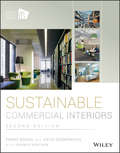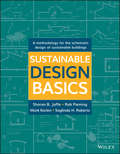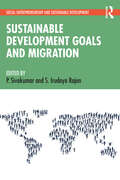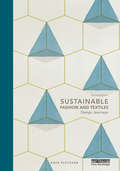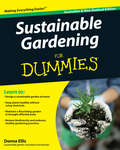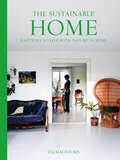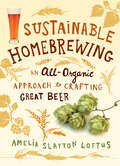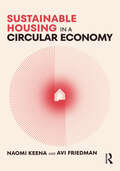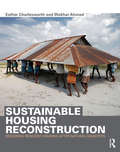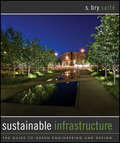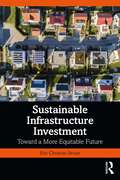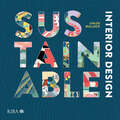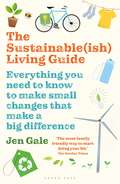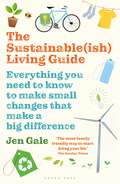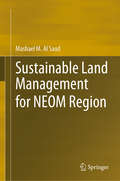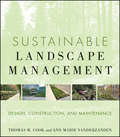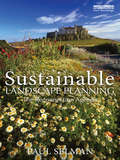- Table View
- List View
Sustainable Commercial Interiors
by Penny Bonda Katie SosnowchikDiscover new approaches to green design and sustainable building with this comprehensive guide There's a substantial amount of information designers and architects need to understand about sustainability and commercial projects, especially as expectations for professionals in the industry become clearer. Luckily, the second edition of Sustainable Commercial Interiors has been revamped to serve as a comprehensive guide for anyone looking to understand the latest in green and sustainable design. Fully revised throughout, this resource now includes frameworks based on the new LEED v4 rating system, and provides fifteen brand-new case studies that document green design and building strategies for all types of projects. You'll find information on materials, furnishings, finishes, product standards, and certifications, all designed to keep you in the know and prepare you for future ventures in sustainable design. The ideal professional companion for interior designers, commercial builders and developers, architects, and interior design students, this guide is an all-in-one introduction to the most essential topics in the industry, such as global environmental issues, water and energy usage, and the tools of the trade, to name just a few. The book is illustrated with full color images throughout. Fully revised and updated to include information on the new LEED v4 rating system Discusses the past, present, and future of sustainable design Considers global environmental issues, such as waste, land use, and bio-inspired design Covers water and energy usage and sustainable materials Discover the benefits of green building and adopt new approaches to sustainable design. Sustainable Commercial Interiors is your go-to resource for navigating new expectations for responsible interior design.
Sustainable Design Basics
by Sharon B. Jaffe Rob Fleming Mark Karlen Saglinda H. RobertsAn accessible, climate-diverse guide that transforms readers from sustainable design novices to whole-solution problem solvers. Sustainable Design Basics is a student-friendly introduction to a holistic and integral view of sustainable design. Comprehensive in scope, this textbook presents basic technical information, sustainability strategies, and a practical, step-by-step approach for sustainable building projects. Clear and relatable chapters illustrate how to identify the factors that reduce energy use, solve specific sustainable design problems, develop holistic design solutions, and address the social and cultural aspects of sustainable design. Requiring no prior knowledge of the subject, the text’s easy-to-follow methodology leads readers through the fundamental sustainable design principles for the built environment. Sustainably-constructed and maintained buildings protect the health and improve the productivity of their occupants, as well as help to restore the global ecosystem. The authors, leading practitioners and educators in sustainable design, have created a resource that provides a solid introduction to broad level sustainability thinking that students can take forward into their professional practice. Topics include space planning for sustainable design, integrative and collaborative design, standards and rating systems, real-world strategies to conserve energy and resources through leveraging renewable natural resources and innovative construction techniques and their impact on our environment. Usable and useful both in and beyond the classroom, this book: Covers building location strategies, building envelopes and structures, integration of passive and active systems, green materials, and project presentation Examines cultural factors, social equity, ecological systems, and aesthetics Provides diverse student exercises that vary by climate, geography, setting, perspective, and typology Features a companion website containing videos for each sustainable strategy, matrices, templates, Sketch-Up and AutoCAD files, PowerPoint slides, and extensive instructor resources Sustainable Design Basics is an important resource aimed at undergraduate architecture and interior design students, or first-year graduate students, as well as design professionals wishing to integrate sustainable design knowledge and techniques into their practice.
Sustainable Development Goals and Migration (Towards Sustainable Futures)
by P. Sivakumar S. Irudaya RajanThis book looks at migration in contemporary society and its interrelations with development. It presents the complexities and dilemmas associated with migration, the changes in theoretical and historical perspectives on migration and development, and the role of policies and the sustainable development goals in this context. The volume views migration as a phenomenon for advancing human development outcomes. It deals with wide-ranging issues including labour migration, the idea of decent work, migration and transnationalism, remittances, social networks and capital, and addressing poverty. The chapters highlight the focus of the Sustainable Development Goals (SDGs) and its relevance on migrant rights, safeguarding livelihoods and health. They also offer insights into regional and international co-operation on policies for migration, social growth and protection, and citizenship. With comparative analyses of data, trends and development indicators as well as various case studies, this volume examines the impact of migration on international relations and politics, labour market outcomes, gender, youth and education among others. It also discusses the loss of lives and livelihoods due to the Covid-19 pandemic, its impact on migration and the effects of the pandemic on the contemporary discussions on migration and SDGs. Rich in empirical data, this book will be an excellent read for scholars and researchers of migration and diaspora studies, development studies, refugee studies, public policy and governance, international relations, political studies, political economy, sociology and South Asian Studies.
Sustainable Development Goals and Migration (Towards Sustainable Futures)
by P. Sivakumar S. Irudaya RajanThis book looks at migration in contemporary society and its interrelations with development. It presents the complexities and dilemmas associated with migration, the changes in theoretical and historical perspectives on migration and development, and the role of policies and the sustainable development goals in this context. The volume views migration as a phenomenon for advancing human development outcomes. It deals with wide-ranging issues including labour migration, the idea of decent work, migration and transnationalism, remittances, social networks and capital, and addressing poverty. The chapters highlight the focus of the Sustainable Development Goals (SDGs) and its relevance on migrant rights, safeguarding livelihoods and health. They also offer insights into regional and international co-operation on policies for migration, social growth and protection, and citizenship. With comparative analyses of data, trends and development indicators as well as various case studies, this volume examines the impact of migration on international relations and politics, labour market outcomes, gender, youth and education among others. It also discusses the loss of lives and livelihoods due to the Covid-19 pandemic, its impact on migration and the effects of the pandemic on the contemporary discussions on migration and SDGs. Rich in empirical data, this book will be an excellent read for scholars and researchers of migration and diaspora studies, development studies, refugee studies, public policy and governance, international relations, political studies, political economy, sociology and South Asian Studies.
Sustainable Fashion and Textiles: Design Journeys
by Kate FletcherPraise for the previous edition: "[A] fascinating book." John Thackara, Doors of Perception "Provides the foundations for a radical new perspective." Ethical Pulse "At last a book that dispels the idea that fashion is only interested in trend-driven fluff: not only does it have a brain, but it could be a sustainable one." Lucy Siegle, Crafts Magazine ? Fully revised and updated, the second edition of Sustainable Fashion and Textiles: Design Journeys continues to define the field of design in fashion and textiles. Arranged in two sections, the first four chapters represent key stages of the lifecycle: material cultivation/extraction, production, use and disposal. The remaining four chapters explore design approaches for altering the scale and nature of consumption, including service design, localism, speed and user involvement. While each chapter is complete in and of itself, their real value comes from what they represent together: innovative ways of thinking about textiles and garments based on sustainability values and an interconnected approach to design. Including a new preface, updated content and a new conclusion reflecting and critiquing developments in the field, as well as discussing future developments, the second edition promises to provide further impetus for future change, sealing Sustainable Fashion and Textiles: Design Journeys as the must-buy book for fashion and textiles professionals and students interested in sustainability.
Sustainable Fashion and Textiles: Design Journeys
by Kate FletcherPraise for the previous edition: "[A] fascinating book." John Thackara, Doors of Perception "Provides the foundations for a radical new perspective." Ethical Pulse "At last a book that dispels the idea that fashion is only interested in trend-driven fluff: not only does it have a brain, but it could be a sustainable one." Lucy Siegle, Crafts Magazine ? Fully revised and updated, the second edition of Sustainable Fashion and Textiles: Design Journeys continues to define the field of design in fashion and textiles. Arranged in two sections, the first four chapters represent key stages of the lifecycle: material cultivation/extraction, production, use and disposal. The remaining four chapters explore design approaches for altering the scale and nature of consumption, including service design, localism, speed and user involvement. While each chapter is complete in and of itself, their real value comes from what they represent together: innovative ways of thinking about textiles and garments based on sustainability values and an interconnected approach to design. Including a new preface, updated content and a new conclusion reflecting and critiquing developments in the field, as well as discussing future developments, the second edition promises to provide further impetus for future change, sealing Sustainable Fashion and Textiles: Design Journeys as the must-buy book for fashion and textiles professionals and students interested in sustainability.
Sustainable Gardening For Dummies (For Dummies Ser.)
by Donna EllisCreated especially for the Australian customer! Reduce your environmental footprint in the garden with this practical guide With all the talk about the health of the planet, you've probably heard about sustainability. Now you can apply these principles in your own backyard, whether that's an Aussie apartment balcony or a sprawling Kiwi rural spread. Find out great techniques for planning your sustainable garden and keeping your plants - and you - happy and healthy. Plant nutrients - what are they and how can you supply them to your plants sustainably? Watering techniques - how much water does your garden really need, and how can you conserve and supply it? Landscaping and gardening materials - where do they come from and are they sustainable? Biodiversity - how do you help increase the biodiversity of the planet through your own gardening practices? Organic gardening, permaculture and biodynamics - what methods can you adopt to improve your sustainable garden? Weeds and pests - how are they defined, and how do you control them while being kind to the environment? Compost heaps and worm farms - how do you build and maintain them, and what do they do for your garden? Potting mix - how can you choose a sustainable product or even make your own?
The Sustainable Home: Easy Ways To Live With Nature In Mind
by Ida MagntornHandy and inspirational tips and lists – how to reduce plastic consumption, clean with eco-friendly products and working with the seasons to bring the outdoors inside. A beautifully produced book on interiors with a focus on sustainability and wellbeing and creating a home with the environment in mind.
Sustainable Homebrewing: An All-Organic Approach to Crafting Great Beer
by Amelia Slayton LoftusBrew delicious organic beer at home. In this comprehensive guide, Amelia Slayton Loftus covers everything you need to know to brew at home with organic ingredients, stressing practices that minimize waste and use sustainable resources. Along with 30 irresistible recipes, Loftus provides expert tips on buying equipment, harnessing solar energy, recycling water, using spent grain, and growing your own organic barley, hops, and herbs. You&’ll enjoy brewing homemade beer that not only tastes great, but is good for the environment.
Sustainable Housing in a Circular Economy
by Naomi Keena Avi FriedmanThis book relates circular economy principles to housing design and construction and highlights how those principles can result in both monetary savings, positive environmental impact, and socio-ecological change.Chapters focus on three key circular economy principles and apply them to architectural construction and design, namely rethinking of the end-of-use phase of a building and the potential of design-for-disassembly; the role of digitization and data standardization in fostering evidence-based circular economy design decision-making; and presenting space as a resource to conserve, via exploration of the sharing economy and flexibility principles. Beyond waste management and material cycles, this book provides a holistic understanding of the opportunities across the building life cycle that can allow for sustainable and affordable circular housing. With case studies from 13 different countries, including but not limited to the Hammarby Sjöstad district in Sweden, the Circle House in Denmark, Benny Farm in Canada, VMD Prefabricated House in Mexico, and the Deep Performance Dwelling in China, authors pair theoretical frameworks with real-world examples.This will be a useful resource for upper-level students and academics of architecture, construction, and planning, especially those studying and researching housing design, building technology, green project management, and environmental design.
Sustainable Housing in a Circular Economy
by Naomi Keena Avi FriedmanThis book relates circular economy principles to housing design and construction and highlights how those principles can result in both monetary savings, positive environmental impact, and socio-ecological change.Chapters focus on three key circular economy principles and apply them to architectural construction and design, namely rethinking of the end-of-use phase of a building and the potential of design-for-disassembly; the role of digitization and data standardization in fostering evidence-based circular economy design decision-making; and presenting space as a resource to conserve, via exploration of the sharing economy and flexibility principles. Beyond waste management and material cycles, this book provides a holistic understanding of the opportunities across the building life cycle that can allow for sustainable and affordable circular housing. With case studies from 13 different countries, including but not limited to the Hammarby Sjöstad district in Sweden, the Circle House in Denmark, Benny Farm in Canada, VMD Prefabricated House in Mexico, and the Deep Performance Dwelling in China, authors pair theoretical frameworks with real-world examples.This will be a useful resource for upper-level students and academics of architecture, construction, and planning, especially those studying and researching housing design, building technology, green project management, and environmental design.
Sustainable Housing Reconstruction: Designing resilient housing after natural disasters
by Esther Charlesworth Iftekhar AhmedThrough 12 case studies from Australia, Bangladesh, Haiti, Sri Lanka, Vietnam and the USA, this book focuses on the housing reconstruction process after an earthquake, tsunami, cyclone, flood or fire. Design of post-disaster housing is not simply replacing the destroyed house but, as these case studies highlight, a means to not only build a safer house but also a more resilient community; not to simply return to the same condition as before the disaster, but an opportunity for building back better. The book explores two main themes: Housing reconstruction is most successful when involving the users in the design and construction process Housing reconstruction is most effective when it is integrated with community infrastructure, services and the means to create real livelihoods. The case studies included in this book highlight work completed by different agencies and built environment professionals in diverse disaster-affected contexts. With a global acceleration of natural disasters, often linked to accelerating climate change, there is a critical demand for robust housing solutions for vulnerable communities. This book provides professionals, policy makers and community stakeholders working in the international development and disaster risk management sectors, with an evidence-based exploration of how to add real value through the design process in housing reconstruction. Herein then, the knowledge we need to build, an approach to improve our processes, a window to understanding the complex domain of post-disaster housing reconstruction.
Sustainable Housing Reconstruction: Designing resilient housing after natural disasters
by Esther Charlesworth Iftekhar AhmedThrough 12 case studies from Australia, Bangladesh, Haiti, Sri Lanka, Vietnam and the USA, this book focuses on the housing reconstruction process after an earthquake, tsunami, cyclone, flood or fire. Design of post-disaster housing is not simply replacing the destroyed house but, as these case studies highlight, a means to not only build a safer house but also a more resilient community; not to simply return to the same condition as before the disaster, but an opportunity for building back better. The book explores two main themes: Housing reconstruction is most successful when involving the users in the design and construction process Housing reconstruction is most effective when it is integrated with community infrastructure, services and the means to create real livelihoods. The case studies included in this book highlight work completed by different agencies and built environment professionals in diverse disaster-affected contexts. With a global acceleration of natural disasters, often linked to accelerating climate change, there is a critical demand for robust housing solutions for vulnerable communities. This book provides professionals, policy makers and community stakeholders working in the international development and disaster risk management sectors, with an evidence-based exploration of how to add real value through the design process in housing reconstruction. Herein then, the knowledge we need to build, an approach to improve our processes, a window to understanding the complex domain of post-disaster housing reconstruction.
Sustainable Infrastructure: The Guide to Green Engineering and Design
by S. Bry SarteAs more factors, perspectives, and metrics are incorporated into the planning and building process, the roles of engineers and designers are increasingly being fused together. Sustainable Infrastructure explores this trend with in-depth look at sustainable engineering practices in an urban design as it involves watershed master-planning, green building, optimizing water reuse, reclaiming urban spaces, green streets initiatives, and sustainable master-planning. This complete guide provides guidance on the role creative thinking and collaborative team-building play in meeting solutions needed to affect a sustainable transformation of the built environment.
Sustainable Infrastructure: The Guide to Green Engineering and Design
by S. Bry SarteAs more factors, perspectives, and metrics are incorporated into the planning and building process, the roles of engineers and designers are increasingly being fused together. Sustainable Infrastructure explores this trend with in-depth look at sustainable engineering practices in an urban design as it involves watershed master-planning, green building, optimizing water reuse, reclaiming urban spaces, green streets initiatives, and sustainable master-planning. This complete guide provides guidance on the role creative thinking and collaborative team-building play in meeting solutions needed to affect a sustainable transformation of the built environment.
Sustainable Infrastructure Investment: Toward a More Equitable Future
by Eric Christian BruunThis book provides examples and suggestions for readers to understand how public investment decisions for sustainable infrastructure are made. Through detailed analysis of public investment in infrastructure over the last few decades in the United States, the United Kingdom, and Finland, the author explores how the decision-making processes for major public works spending, many of them requiring quite rigorous and detailed computational methodologies, can result in plans that underserve large portions of the population, are inequitable, and fail to efficiently preserve public property. Beginning with some of the commonly offered explanations for the slow pace of investment and repair in a supposedly prosperous society facing serious environmental challenges, the book then explores media’s role in shaping the public-at-large’s understanding of the situation and the unimaginative solutions put forward by politicians. It continues with some case studies of infrastructure investment, or lack thereof, including an exploration of competing uses for government funds. It concludes with some suggestions. It is aimed at a large readership of professionals, students, and policy makers in political science, urban planning, and civil engineering.
Sustainable Infrastructure Investment: Toward a More Equitable Future
by Eric Christian BruunThis book provides examples and suggestions for readers to understand how public investment decisions for sustainable infrastructure are made. Through detailed analysis of public investment in infrastructure over the last few decades in the United States, the United Kingdom, and Finland, the author explores how the decision-making processes for major public works spending, many of them requiring quite rigorous and detailed computational methodologies, can result in plans that underserve large portions of the population, are inequitable, and fail to efficiently preserve public property. Beginning with some of the commonly offered explanations for the slow pace of investment and repair in a supposedly prosperous society facing serious environmental challenges, the book then explores media’s role in shaping the public-at-large’s understanding of the situation and the unimaginative solutions put forward by politicians. It continues with some case studies of infrastructure investment, or lack thereof, including an exploration of competing uses for government funds. It concludes with some suggestions. It is aimed at a large readership of professionals, students, and policy makers in political science, urban planning, and civil engineering.
Sustainable Interior Design
by Chloe BullockWhat does it mean to be a sustainable interior designer? Where do you start? This book demystifies how to be a sustainable interior designer, both within practice and on design projects. It gives you the tools to educate clients that sustainable practice isn’t necessarily more expensive, and what the options available to them are in terms of design concept, materials and finishes. Importantly, the book also looks at sustainable supply chains, particularly important when specifying FF+E. Where to start being sustainable can be a difficult decision. Acting as a primer for interior designers at any stage of their career, it outlines what you really need – and don’t need – to know. Inspirational case studies from around the world sit alongside crucial guidance on the benefits of being sustainable and how to work with enlightened clients. There is information on how sustainable design contributes to health and wellbeing, all backed up by authoritative best practice guidance.
Sustainable Interior Design
by Chloe BullockWhat does it mean to be a sustainable interior designer? Where do you start? This book demystifies how to be a sustainable interior designer, both within practice and on design projects. It gives you the tools to educate clients that sustainable practice isn’t necessarily more expensive, and what the options available to them are in terms of design concept, materials and finishes. Importantly, the book also looks at sustainable supply chains, particularly important when specifying FF+E. Where to start being sustainable can be a difficult decision. Acting as a primer for interior designers at any stage of their career, it outlines what you really need – and don’t need – to know. Inspirational case studies from around the world sit alongside crucial guidance on the benefits of being sustainable and how to work with enlightened clients. There is information on how sustainable design contributes to health and wellbeing, all backed up by authoritative best practice guidance.
The Sustainable(ish) Living Guide: Everything you need to know to make small changes that make a big difference
by Jen GaleEasy, do-able, down to earth ideas and suggestions for everyone to help save the planet.If you want to save the planet, but your to-do list is already pretty long and remembering your re-usable coffee cup feels like a Herculean task, then this is the book for you. Covering every aspect of our lives from the stuff we buy and the food we eat, to how we travel, work, and celebrate. This book provides stacks of practical, down to earth ideas to slot into your daily life, alongside a gentle kick up the butt to put your newfound knowledge into action. Practical tips include unsubscribing from all the tempting emails that drop into your inbox with details of the newest clothing range or the latest sale, and keeping a mug next to your kettle to work out how much water you actually need to boil each time, as over filling kettles costs British households £68 million on energy bills each year.Find out how to fit "sustainable living" into your life, in a way that works for you. Change your impact without radically changing your life and figure out the small steps you can make that will add up to make a big difference (halo not included).
The Sustainable(ish) Living Guide: Everything you need to know to make small changes that make a big difference
by Jen GaleEasy, do-able, down to earth ideas and suggestions for everyone to help save the planet.If you want to save the planet, but your to-do list is already pretty long and remembering your re-usable coffee cup feels like a Herculean task, then this is the book for you. Covering every aspect of our lives from the stuff we buy and the food we eat, to how we travel, work, and celebrate. This book provides stacks of practical, down to earth ideas to slot into your daily life, alongside a gentle kick up the butt to put your newfound knowledge into action. Practical tips include unsubscribing from all the tempting emails that drop into your inbox with details of the newest clothing range or the latest sale, and keeping a mug next to your kettle to work out how much water you actually need to boil each time, as over filling kettles costs British households £68 million on energy bills each year.Find out how to fit "sustainable living" into your life, in a way that works for you. Change your impact without radically changing your life and figure out the small steps you can make that will add up to make a big difference (halo not included).
Sustainable Land Management for NEOM Region
by Mashael M. Al SaudThis book is the first of its type on NEOM Region, NW of Saudi Arabia. This region has been designated in 2017 to be an international economic hub. However, no studies have been done on this region which occupies several natural resources including remarkable landscape with unique ecological species, ores and water resources. The region is also vulnerable to many aspects of threatening natural hazards.Based on her expertise, namely geomorphological processes, earth sciences, space techniques and natural risk assessment, the author made an initiative to produce this book using advanced tools, specifically satellite images and geo-information system. The book introduces several thematic maps obtained for the first time for NEOM Region. Hence, it represents a scientific guide for land management and urban planning approaches. This book is a very significant document for a variety of readers and researchers including decision makers, land managers and planners, as well as geographers and geologists. In addition, the basic concepts and new approaches attract researchers and academic teams including students, universities and research centers not only in Saudi Arabia, but in different parts of the World.
Sustainable Landscape Management: Design, Construction, and Maintenance
by Ann Marie VanDerZanden Thomas W. CookTHE COMPLETE GUIDE TO THE SUSTAINABLE MANAGEMENT OF LANDSCAPES A must-have guide for anyone working with landscapes, Sustainable Landscape Management eases the transition of the landscape industry into a new era of green consciousness. Filled with examples that illustrate best practices, the book provides a practical framework for the development of sustainable management strategies from design to execution and, eventually, to maintenance in an effort to construct landscapes that function more efficiently and minimize the impact on the environment. Sustainable Landscape Management includes: An overview of sustainable design and construction techniques as the basis for the maintenance and management of constructed landscapes Coverage of ecosystem development, managing landscape beds, managing trees and shrubs, and lawn care An entire chapter devoted to issues associated with the use of chemicals in landscape management Guidance on retrofitting existing landscapes for sustainability Reshaping the landscape takes on more significance as society embraces a new value system for advancing environmentally friendly ideals. By following the management principles laid out in this book, readers will learn the key elements for building landscapes that integrate beauty and function to create a sustainable presence that extends well into the future.
Sustainable Landscape Management: Design, Construction, and Maintenance
by Ann Marie VanDerZanden Thomas W. CookTHE COMPLETE GUIDE TO THE SUSTAINABLE MANAGEMENT OF LANDSCAPES A must-have guide for anyone working with landscapes, Sustainable Landscape Management eases the transition of the landscape industry into a new era of green consciousness. Filled with examples that illustrate best practices, the book provides a practical framework for the development of sustainable management strategies from design to execution and, eventually, to maintenance in an effort to construct landscapes that function more efficiently and minimize the impact on the environment. Sustainable Landscape Management includes: An overview of sustainable design and construction techniques as the basis for the maintenance and management of constructed landscapes Coverage of ecosystem development, managing landscape beds, managing trees and shrubs, and lawn care An entire chapter devoted to issues associated with the use of chemicals in landscape management Guidance on retrofitting existing landscapes for sustainability Reshaping the landscape takes on more significance as society embraces a new value system for advancing environmentally friendly ideals. By following the management principles laid out in this book, readers will learn the key elements for building landscapes that integrate beauty and function to create a sustainable presence that extends well into the future.
Sustainable Landscape Planning: The Reconnection Agenda
by Paul SelmanThis book takes as its starting point the need to examine critically the case for landscape reconnection. It looks at alleged disconnections and their supposed consequences. It explores the arguments about reconnecting the natural and human elements of whole landscapes. More broadly, it considers landscape as an arena within which science, humanities and professions can find common ground, and in which vivid social learning can occur about key social and environmental issues. It takes a dynamic view of landscape, in contrast to the popular image of timeless, traditional scenery. It accepts that even the most cherished cultural landscapes will change and, indeed, it views ‘change drivers’ as a potentially positive means of creating new connectivities between people and place. It recognises the growing interest in promoting resilience and ecosystem services across extensive landscapes - such as by creating new 'space' for water and wildlife. ?
